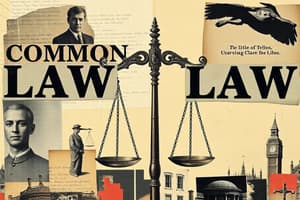Podcast
Questions and Answers
What does the term 'common law' refer to?
What does the term 'common law' refer to?
The law made by judicial decisions set by courts over time.
Explain what the Magna Carta is and its significance in the development of law.
Explain what the Magna Carta is and its significance in the development of law.
The Magna Carta, which means 'Great Charter,' was a document that outlined the limitations on the rights of the crown. It was signed in 1215 after King John of England was forced to sign it at sword point. This was the first constitution, as it was the first written document that limited the powers of the king, establishing a stronger legal foundation.
Which of the following are types of punishment under the Retribution school of thought?
Which of the following are types of punishment under the Retribution school of thought?
- Compensation.
- Rehabilitation.
- Restitution. (correct)
- Payback/vengeance (correct)
Procedural law ensures that everyone is treated fairly by the criminal justice system.
Procedural law ensures that everyone is treated fairly by the criminal justice system.
Which legal system emphasizes the role of the judge as a 'referee'?
Which legal system emphasizes the role of the judge as a 'referee'?
The "Reasonable Limits Clause" is used to determine:
The "Reasonable Limits Clause" is used to determine:
What is the purpose of the "Notwithstanding Clause" in the Canadian Charter of Rights and Freedoms?
What is the purpose of the "Notwithstanding Clause" in the Canadian Charter of Rights and Freedoms?
Which of the following is NOT a fundamental freedom protected by the Canadian Charter of Rights and Freedoms?
Which of the following is NOT a fundamental freedom protected by the Canadian Charter of Rights and Freedoms?
Hybrid offences in the Canadian legal system can be classified as either indictable or summary offences, as decided by the Crown.
Hybrid offences in the Canadian legal system can be classified as either indictable or summary offences, as decided by the Crown.
Name two major purposes of sentencing.
Name two major purposes of sentencing.
What is the primary purpose of the Oakes Test?
What is the primary purpose of the Oakes Test?
The term 'Actus reus' refers to the guilty mind or mens rea of a crime.
The term 'Actus reus' refers to the guilty mind or mens rea of a crime.
Define 'quasi-criminal offences' and explain why they are important.
Define 'quasi-criminal offences' and explain why they are important.
What is the purpose of 'due process' within a legal system?
What is the purpose of 'due process' within a legal system?
The "burden of proof" in a criminal case lies with the defendant to prove their innocence.
The "burden of proof" in a criminal case lies with the defendant to prove their innocence.
What is the 'reasonable limits' clause? Where does this clause apply? Explain its purpose in the context of the Canadian Charter of Rights and Freedoms?
What is the 'reasonable limits' clause? Where does this clause apply? Explain its purpose in the context of the Canadian Charter of Rights and Freedoms?
Which of the following is NOT a type of liability recognized in the Canadian legal system?
Which of the following is NOT a type of liability recognized in the Canadian legal system?
What is the concept of 'negligence' in tort law? How is it different from 'strict liability'?
What is the concept of 'negligence' in tort law? How is it different from 'strict liability'?
The term 'recidivism' refers to the act of an offender re-offending after having served their sentence.
The term 'recidivism' refers to the act of an offender re-offending after having served their sentence.
Briefly describe the core principle of the 'Restorative Justice' approach.
Briefly describe the core principle of the 'Restorative Justice' approach.
What is one of the primary benefits of using the Adversarial System in legal proceedings?
What is one of the primary benefits of using the Adversarial System in legal proceedings?
Explain the main difference between the Inquisitorial System and the Adversarial System.
Explain the main difference between the Inquisitorial System and the Adversarial System.
Within the Canadian context, what is the core principle of "The Rule of Law"?
Within the Canadian context, what is the core principle of "The Rule of Law"?
Which of the following best reflects the concept of "The Rule of Law" in the Canadian context?
Which of the following best reflects the concept of "The Rule of Law" in the Canadian context?
Why is the right to a fair trial a fundamental right in the Canadian context? Briefly explain its importance.
Why is the right to a fair trial a fundamental right in the Canadian context? Briefly explain its importance.
How can the 'Notwithstanding Clause' be used to potentially contradict or undermine the fundamental rights protected by the Canadian Charter of Rights and Freedoms?
How can the 'Notwithstanding Clause' be used to potentially contradict or undermine the fundamental rights protected by the Canadian Charter of Rights and Freedoms?
Provide one example of a landmark case in Canadian law where the Charter of Rights and Freedoms was used to protect an individuals' right to freedom of religion.
Provide one example of a landmark case in Canadian law where the Charter of Rights and Freedoms was used to protect an individuals' right to freedom of religion.
In the Canadian context, how has the "Rule of Law" been applied in situations involving protests and demonstrations?
In the Canadian context, how has the "Rule of Law" been applied in situations involving protests and demonstrations?
Flashcards
Common Law/Case Law
Common Law/Case Law
A system of law based on precedent set by judicial decisions over time. It ensures consistency as judges must rule based on similar past cases and allows flexibility as laws adapt.
Code of Hammurabi
Code of Hammurabi
The oldest known codified law, created in ancient Babylon. It established the standard for writing down laws and ensuring consistency within a jurisdiction.
Retribution
Retribution
Punishment based on a sense of payback or vengeance. It's about satisfying the victim's need to see the wrongdoer punished.
Jurisdiction
Jurisdiction
Signup and view all the flashcards
Restitution
Restitution
Signup and view all the flashcards
Procedural Law
Procedural Law
Signup and view all the flashcards
Rule of Law
Rule of Law
Signup and view all the flashcards
Magna Carta
Magna Carta
Signup and view all the flashcards
Rehabilitation
Rehabilitation
Signup and view all the flashcards
Inquisitorial System
Inquisitorial System
Signup and view all the flashcards
Adversarial System
Adversarial System
Signup and view all the flashcards
Reasonable Limits Clause
Reasonable Limits Clause
Signup and view all the flashcards
Notwithstanding Clause
Notwithstanding Clause
Signup and view all the flashcards
Equality Rights
Equality Rights
Signup and view all the flashcards
R v Morgentaler
R v Morgentaler
Signup and view all the flashcards
Sauvé v Canada
Sauvé v Canada
Signup and view all the flashcards
The White Paper
The White Paper
Signup and view all the flashcards
R v Keegstra
R v Keegstra
Signup and view all the flashcards
Rodriguez v. B.C.
Rodriguez v. B.C.
Signup and view all the flashcards
Immigration Act, 1976
Immigration Act, 1976
Signup and view all the flashcards
R v Vriend
R v Vriend
Signup and view all the flashcards
Due Process
Due Process
Signup and view all the flashcards
Reasonable Doubt
Reasonable Doubt
Signup and view all the flashcards
Acquittal
Acquittal
Signup and view all the flashcards
Recidivism
Recidivism
Signup and view all the flashcards
Criminal Code of Canada
Criminal Code of Canada
Signup and view all the flashcards
Circumstantial Evidence
Circumstantial Evidence
Signup and view all the flashcards
Direct Evidence
Direct Evidence
Signup and view all the flashcards
Quasi Criminal
Quasi Criminal
Signup and view all the flashcards
Actus Reus
Actus Reus
Signup and view all the flashcards
Mens Rea
Mens Rea
Signup and view all the flashcards
Burden of Proof
Burden of Proof
Signup and view all the flashcards
Parole
Parole
Signup and view all the flashcards
Probation
Probation
Signup and view all the flashcards
Study Notes
Legal Foundations Unit
- Common Law is law made by judicial decisions over time; ensures consistency as judges must rule based on similar cases, allowing for flexibility as laws change.
- Procedural Law governs the processes of law (courts and police), ensuring fair treatment for all.
- The Code of Hammurabi was an early Babylonian legal text (1755-1750 BC), establishing codified laws.
- Magna Carta (Greater Charter) outlined limitations on the King's power and is considered the first constitution. It established that even the King is not above the law.
- Retribution is punishment based on payback or vengeance; Restitution is compensation for victims.
- Jurisdiction defines the scope of authority of different courts and agencies.
- An adversarial system (common in criminal cases) involves opposing lawyers presenting their cases to a judge who acts as a referee.
- An inquisitorial system (common in civil cases) is where the judge actively questions the parties to build the case.
- The rule of law is the principle that no one is above or below the law.
Human Rights Unit
- R v Morgentaler: Court case on abortion services, established a constitutional right.
- Sauvé v Canada: Inmate's right to vote case.
- The White Paper was a 1969 proposal to eliminate the Indian Act.
- R v Vriend: Established that homophobia is illegal discrimination.
- Greek law provided examples of democratic practices like juries, influential in modern systems.
- Aboriginal law is restorative, focusing on restoring the community from wrong.
- French law is codified, and justice is carried out through the inquisitorial method; present in Ontario/Quebec.
- British Common Law uses precedent from judges' decisions for future rulings and relies on the adversarial method in court.
Criminology and Criminal Procedures Unit
- Circumstantial Evidence: Requires further inferences to prove guilt; less conclusive than direct evidence.
- Direct Evidence: Explicit information with no further need for inference; strong evidence for proving guilt.
- Burden of Proof: The Crown's responsibility to prove guilt in a criminal case.
- Parole is early release from prison, monitored by a parole officer, aiming at reintegration.
- Recidivism is the likelihood of reoffending; is a determining factor in sentencing.
- Criminal Code of Canada defines criminal offenses and punishments, accessible to all citizens.
- Quasi-criminal offences are offenses with substantial penalties that aren't considered strictly criminal (e.g., traffic violations).
Civil Law Unit
- Negligence: Unintentional torts (civil wrongs) caused by carelessness.
- Contract Law: Govern agreements between parties.
- Commercial Law: Applies to companies, business contracts, consumer/public goods/services.
- Duty of Care: Responsibility to consider risks to others when acting.
- Act of God: Defense to negligence if disaster is beyond control.
- Liability: Responsibility for actions or omissions that lead to harm to another person.
- Family Law: Cases involving marriages, divorce, child custody, etc.
- Property Law: Govern intellectual/physical assets; protects property holders.
- Estate Law: Procedures/distribution of wealth after death.
- Due Process: Precise legal/judicial process ensuring fairness.
- Reasonable Doubt is the principle that the courts must be convinced beyond a reasonable doubt the accused committed the crime in question.
Oakes Test
- A test examining the constitutionality of laws that infringe on rights.
- There should be a substantial objective for the law to address the issue and the infringement must be reasonable, which means to be reasonably effective.
- The law's impacts on rights must be proportionate to the benefit provided by the law.
Summary Offenses, Indictable Offenses, and Hybrid Offenses
- Some crimes are more serious/severe (Indictable)
- Some crimes have less serious punishments (Summary)
- Some crimes are considered both by nature and by court's decision (Hybrid)
Purposes of Sentencing
- Deter offender from reoffending, rehabilitate, separate from general society, repairing harm.
Factors of Sentencing
- Criminal's nature, age, family, criminal history, mitigating or aggravating circumstances.
Types of Liability
- Product (manufacturers), occupier (owners of property), vicarious (responsibilities of one for another), strict (automatically liable).
Defences Against Unintentional/Intentional Torts
- Legal defenses to claims involving negligence or intentional wrongdoing
- Consent, self-defense, defense of others, or property, legal authority.
Adversarial and Inquisitorial Systems
- Adversarial: Opposing sides present their case, judge acts as a referee.
- Inquisitorial: Active questioning by the judge to determine the facts, more involved in developing the case.
Public Law
- Laws relating to the government (e.g. Criminal Law, Constitutional Law, Administrative Law)
The Legislative Process
- The steps in creating and passing laws (e.g. first, second, third reading, committee stage).
Aboriginal Law
- A system of law based on the concept of restoring community from wrongdoing
- seen today in how our system addresses restitution and rehabilitation .
Specific Examples (from supplemental info):
- R v Keegstra, R v Big M Drug Mart and R v Vriend are cases discussing freedom of speech, religious rights and discrimination, respectively.
Studying That Suits You
Use AI to generate personalized quizzes and flashcards to suit your learning preferences.





